国际经济学第九版英文课后答案 第7单元
国际经济学第九版英文课后答案第8单元

国际经济学第九版英文课后答案第8单元
*CHAPTER 8 (Core Chapter)
TRADE RESTRICTIONS: TARIFFS
OUTLINE
8.1 Introduction
8.2 Partial Equilibrium Analysis of a T ariff
Case Study 8-1: Average Tariff on Non-Agricultural Products in Major Developed Countries
Case Study 8-2: Average Tariff on Non-Agricultural Products in Some Major
Developing Countries
8.2a Partial Equilibrium Effects of a Tariff
8.2b Effects of a Tariff on Producer and Consumer Surplus
8.2c Costs and Benefits of a Tariff
Case Study 8-3: The Welfare Effects of Liberalizing Trade in Some U.S. Products Case Study 8-4: The Welfare Effects of Liberalizing Trade in Some EU Products 8.3 The Theory of Tariff Structure
8.3a The Rate of Effective Protection
国际经济学第九版英文课后答案第7单元
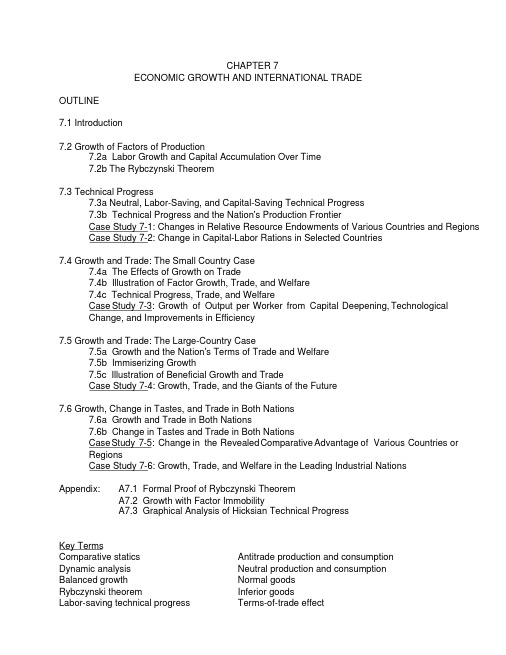
CHAPTER 7
ECONOMIC GROWTH AND INTERNATIONAL TRADE
OUTLINE
7.1 Introduction
7.2 Growth of Factors of Production
7.2a Labor Growth and Capital Accumulation Over Time
7.2b The Rybczynski Theorem
7.3 Technical Progress
7.3a Neutral, Labor-Saving, and Capital-Saving Technical Progress
7.3b Technical Progress and the Nation's Production Frontier
Case Study 7-1: Changes in Relative Resource Endowments of Various Countries and Regions Case Study 7-2: Change in Capital-Labor Rations in Selected Countries
7.4 Growth and Trade: The Small Country Case
7.4a The Effects of Growth on Trade
7.4b Illustration of Factor Growth, Trade, and Welfare
7.4c Technical Progress, Trade, and Welfare
(完整word版)国际经济学第九版英文课后答案 第7单元
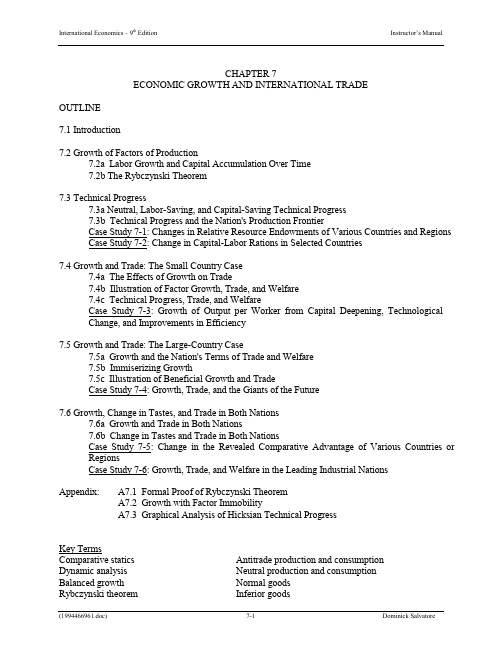
CHAPTER 7
ECONOMIC GROWTH AND INTERNATIONAL TRADE
OUTLINE
7.1 Introduction
7.2 Growth of Factors of Production
7.2a Labor Growth and Capital Accumulation Over Time
7.2b The Rybczynski Theorem
7.3 Technical Progress
7.3a Neutral, Labor-Saving, and Capital-Saving Technical Progress
7.3b Technical Progress and the Nation's Production Frontier
Case Study 7-1: Changes in Relative Resource Endowments of Various Countries and Regions Case Study 7-2: Change in Capital-Labor Rations in Selected Countries
7.4 Growth and Trade: The Small Country Case
7.4a The Effects of Growth on Trade
7.4b Illustration of Factor Growth, Trade, and Welfare
7.4c Technical Progress, Trade, and Welfare
国际金融 第七章 答案
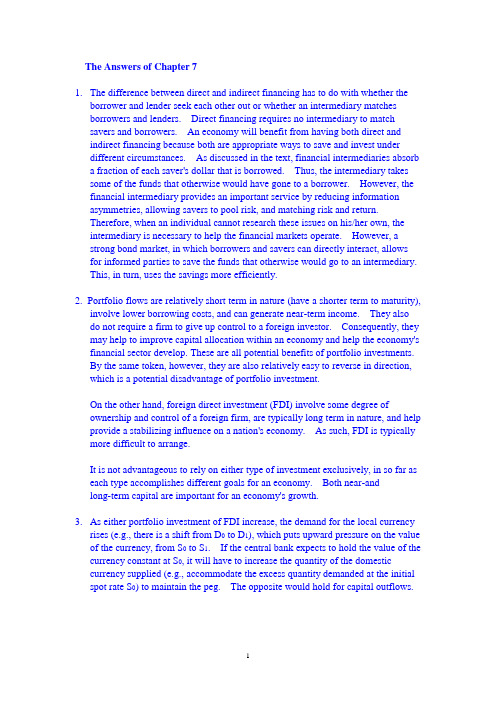
The Answers of Chapter 7
1. The difference between direct and indirect financing has to do with whether the
borrower and lender seek each other out or whether an intermediary matches
borrowers and lenders. Direct financing requires no intermediary to match
savers and borrowers. An economy will benefit from having both direct and
indirect financing because both are appropriate ways to save and invest under
different circumstances. As discussed in the text, financial intermediaries absorb
a fraction of each saver's dollar that is borrowed. Thus, the intermediary takes
some of the funds that otherwise would have gone to a borrower. However, the financial intermediary provides an important service by reducing information
国际经济学第九版英文课后答案第14单元
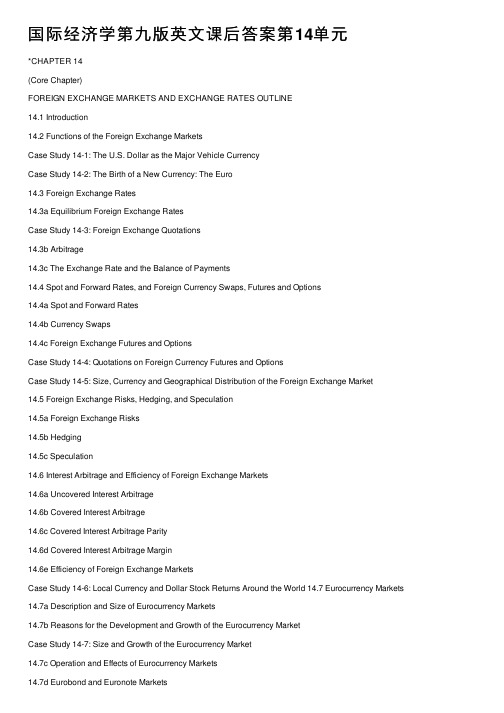
国际经济学第九版英⽂课后答案第14单元
*CHAPTER 14
(Core Chapter)
FOREIGN EXCHANGE MARKETS AND EXCHANGE RATES OUTLINE
14.1 Introduction
14.2 Functions of the Foreign Exchange Markets
Case Study 14-1: The U.S. Dollar as the Major Vehicle Currency
Case Study 14-2: The Birth of a New Currency: The Euro
14.3 Foreign Exchange Rates
14.3a Equilibrium Foreign Exchange Rates
Case Study 14-3: Foreign Exchange Quotations
14.3b Arbitrage
14.3c The Exchange Rate and the Balance of Payments
14.4 Spot and Forward Rates, and Foreign Currency Swaps, Futures and Options
14.4a Spot and Forward Rates
14.4b Currency Swaps
14.4c Foreign Exchange Futures and Options
Case Study 14-4: Quotations on Foreign Currency Futures and Options
曼昆宏观经济学第九版 课后习题答案
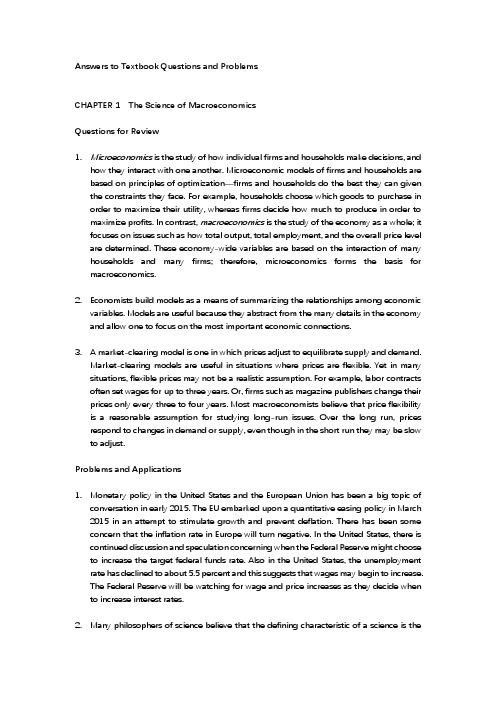
Answers to Textbook Questions and Problems
CHAPTER 1 The Science of Macroeconomics
Questions for Review
1. Microeconomics is the study of how individual firms and households make decisions, and
how they interact with one another. Microeconomic models of firms and households are based on principles of optimization—firms and households do the best they can given the constraints they face. For example, households choose which goods to purchase in order to maximize their utility, whereas firms decide how much to produce in order to maximize profits. In contrast, macroeconomics is the study of the economy as a whole; it focuses on issues such as how total output, total employment, and the overall price level are determined. These economy-wide variables are based on the interaction of many households and many firms; therefore, microeconomics forms the basis for macroeconomics.
ch07 国际经济学课后答案与习题(萨尔瓦多)
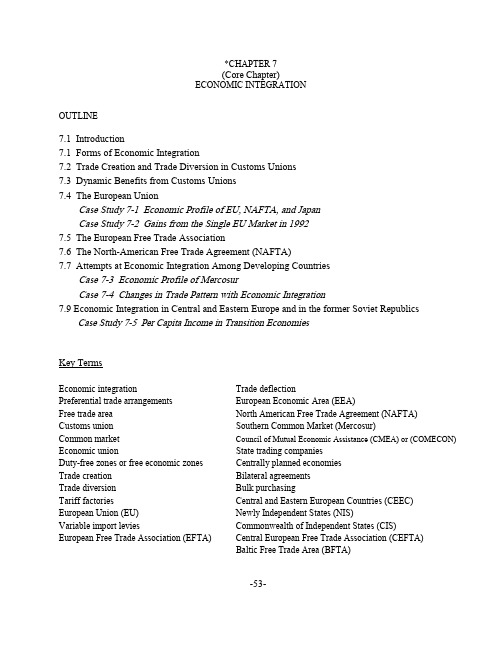
*CHAPTER 7
(Core Chapter)
INTEGRATION
ECONOMIC
OUTLINE
7.1 Introduction
7.1 Forms of Economic Integration
7.2 Trade Creation and Trade Diversion in Customs Unions
7.3 Dynamic Benefits from Customs Unions
7.4 The European Union
Case Study 7-1 Economic Profile of EU, NAFTA, and Japan
Case Study 7-2 Gains from the Single EU Market in 1992
7.5 The European Free Trade Association
7.6 The North-American Free Trade Agreement (NAFTA)
7.7 Attempts at Economic Integration Among Developing Countries
Case 7-3 Economic Profile of Mercosur
Case 7-4 Changes in Trade Pattern with Economic Integration
7.9 Economic Integration in Central and Eastern Europe and in the former Soviet Republics
国际经济学第九版英文课后答案第3单元
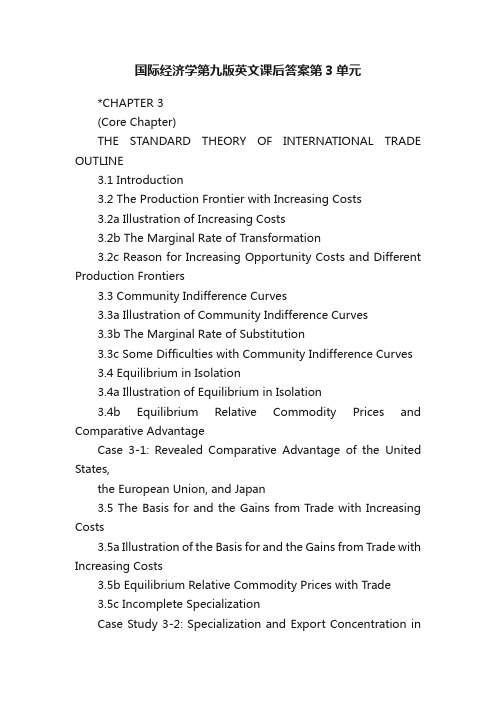
国际经济学第九版英文课后答案第3单元
*CHAPTER 3
(Core Chapter)
THE STANDARD THEORY OF INTERNATIONAL TRADE OUTLINE
3.1 Introduction
3.2 The Production Frontier with Increasing Costs
3.2a Illustration of Increasing Costs
3.2b The Marginal Rate of Transformation
3.2c Reason for Increasing Opportunity Costs and Different Production Frontiers
3.3 Community Indifference Curves
3.3a Illustration of Community Indifference Curves
3.3b The Marginal Rate of Substitution
3.3c Some Difficulties with Community Indifference Curves
3.4 Equilibrium in Isolation
3.4a Illustration of Equilibrium in Isolation
3.4b Equilibrium Relative Commodity Prices and Comparative Advantage
Case 3-1: Revealed Comparative Advantage of the United States,
《国际经济学》——1~7章答案
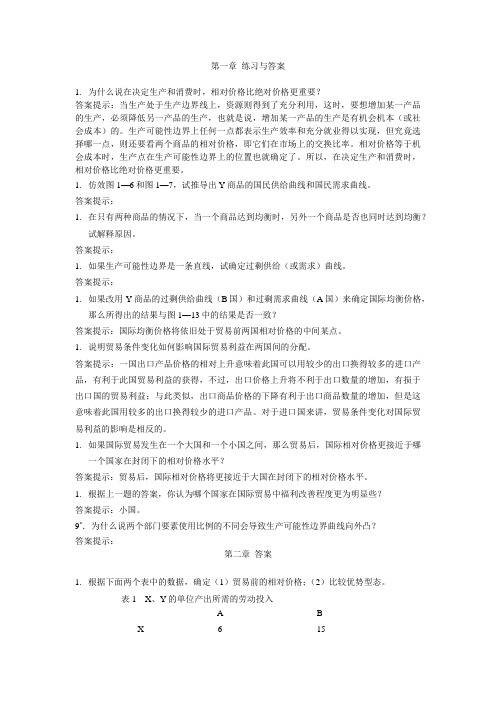
第一章练习与答案
1.为什么说在决定生产和消费时,相对价格比绝对价格更重要?
答案提示:当生产处于生产边界线上,资源则得到了充分利用,这时,要想增加某一产品的生产,必须降低另一产品的生产,也就是说,增加某一产品的生产是有机会机本(或社会成本)的。生产可能性边界上任何一点都表示生产效率和充分就业得以实现,但究竟选择哪一点,则还要看两个商品的相对价格,即它们在市场上的交换比率。相对价格等于机会成本时,生产点在生产可能性边界上的位置也就确定了。所以,在决定生产和消费时,相对价格比绝对价格更重要。
1.仿效图1—6和图1—7,试推导出Y商品的国民供给曲线和国民需求曲线。
答案提示:
1.在只有两种商品的情况下,当一个商品达到均衡时,另外一个商品是否也同时达到均衡?
试解释原因。
答案提示:
1.如果生产可能性边界是一条直线,试确定过剩供给(或需求)曲线。
答案提示:
1.如果改用Y商品的过剩供给曲线(B国)和过剩需求曲线(A国)来确定国际均衡价格,
那么所得出的结果与图1—13中的结果是否一致?
答案提示:国际均衡价格将依旧处于贸易前两国相对价格的中间某点。
1.说明贸易条件变化如何影响国际贸易利益在两国间的分配。
答案提示:一国出口产品价格的相对上升意味着此国可以用较少的出口换得较多的进口产品,有利于此国贸易利益的获得,不过,出口价格上升将不利于出口数量的增加,有损于出口国的贸易利益;与此类似,出口商品价格的下降有利于出口商品数量的增加,但是这意味着此国用较多的出口换得较少的进口产品。对于进口国来讲,贸易条件变化对国际贸易利益的影响是相反的。
国际经济学第九版英文课后答案 第14单元
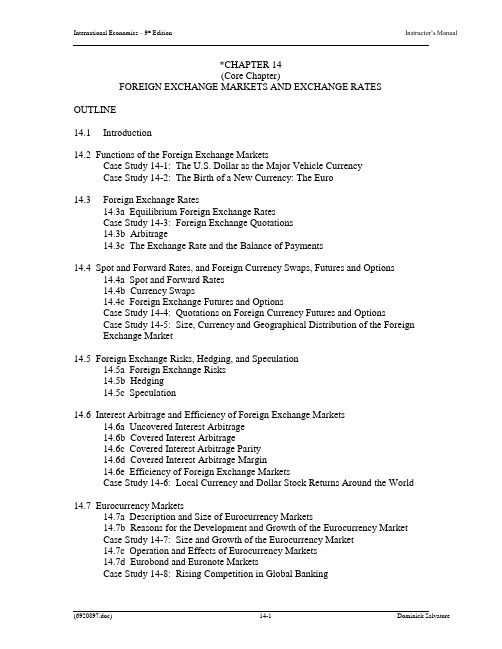
*CHAPTER 14
(Core Chapter)
FOREIGN EXCHANGE MARKETS AND EXCHANGE RATES OUTLINE
14.1 Introduction
14.2 Functions of the Foreign Exchange Markets
Case Study 14-1: The U.S. Dollar as the Major Vehicle Currency
Case Study 14-2: The Birth of a New Currency: The Euro
14.3 Foreign Exchange Rates
14.3a Equilibrium Foreign Exchange Rates
Case Study 14-3: Foreign Exchange Quotations
14.3b Arbitrage
14.3c The Exchange Rate and the Balance of Payments
14.4 Spot and Forward Rates, and Foreign Currency Swaps, Futures and Options
14.4a Spot and Forward Rates
14.4b Currency Swaps
14.4c Foreign Exchange Futures and Options
Case Study 14-4: Quotations on Foreign Currency Futures and Options
国际经济学英文课件chapter7
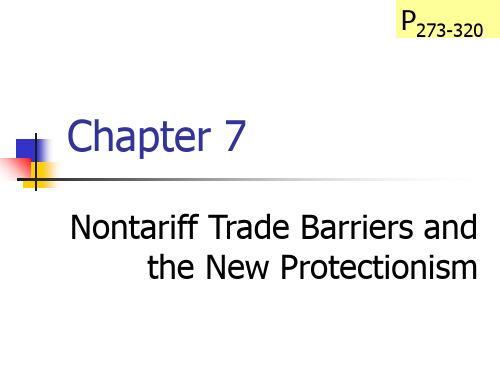
Chapter 6
11
Border taxes
Definition
▪ The case where rebating for internal indirect taxes
given to exporters of a commodity and imposing (in addition to tariff) on importers of a commodity.
P273-320
Chapter 7
Nontariff Trade Barriers and the New Protectionism
Nontariff Trade Barriers
Import Quotas
Voluntary Export Restraints
Technical or Administrative Regulations
Chapter 6
15
7.2.4 Dumping
Case Study 9-2(P282)
Definition
Dumping is the export of a commodity at below cost or at a lower price abroad than domestically.
Buffer Stocks ▪International Cocoa Agreement
国际经济学作业答案第七章
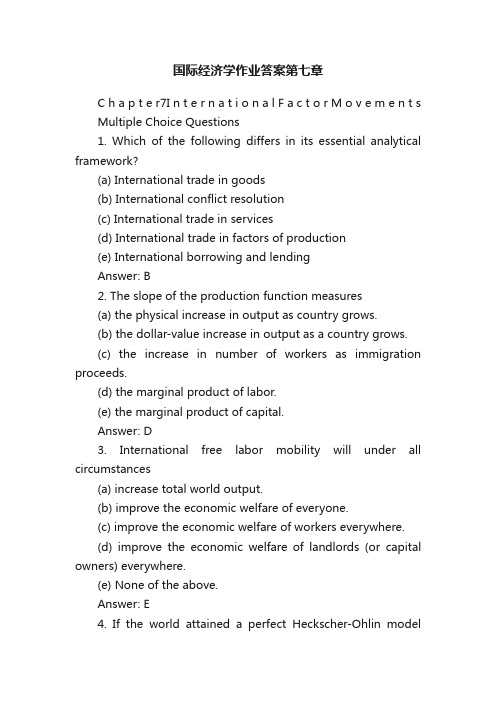
国际经济学作业答案第七章
C h a p t e r7I n t e r n a t i o n a l F a c t o r M o v e m e n t s
Multiple Choice Questions
1. Which of the following differs in its essential analytical framework?
(a) International trade in goods
(b) International conflict resolution
(c) International trade in services
(d) International trade in factors of production
(e) International borrowing and lending
Answer: B
2. The slope of the production function measures
(a) the physical increase in output as country grows.
(b) the dollar-value increase in output as a country grows.
(c) the increase in number of workers as immigration proceeds.
(d) the marginal product of labor.
(e) the marginal product of capital.
国际财务管理课后习题标准答案chapter-7
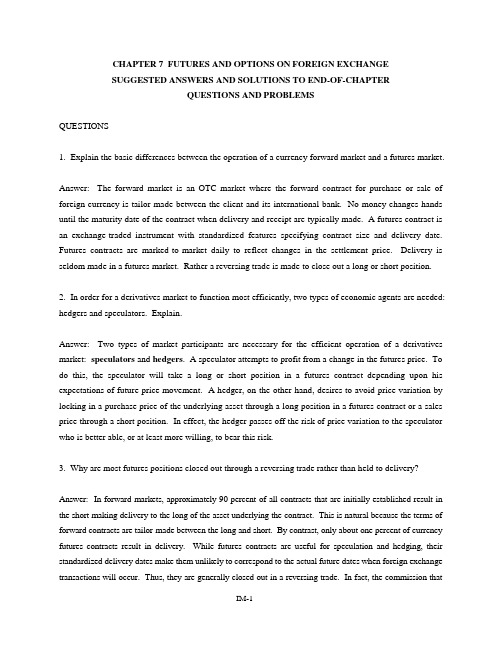
CHAPTER 7 FUTURES AND OPTIONS ON FOREIGN EXCHANGE
SUGGESTED ANSWERS AND SOLUTIONS TO END-OF-CHAPTER
QUESTIONS AND PROBLEMS
QUESTIONS
1. Explain the basic differences between the operation of a currency forward market and a futures market.
Answer: The forward market is an OTC market where the forward contract for purchase or sale of foreign currency is tailor-made between the client and its international bank. No money changes hands until the maturity date of the contract when delivery and receipt are typically made. A futures contract is an exchange-traded instrument with standardized features specifying contract size and delivery date. Futures contracts are marked-to-market daily to reflect changes in the settlement price. Delivery is seldom made in a futures market. Rather a reversing trade is made to close out a long or short position.
国际经济学第九版英文课后答案 第9单元

*CHAPTER 9
(Core Chapter)
NONTARIFF TRADE BARRIERS AND THE NEW PROTECTIONISM OUTLINE
9.1 Introduction
9.2 Import Quotas
9.2a Effects of an Import Quota
Case Study 9-1: The Economic Effects of the U.S. Quota on Sugar Imports
9.2b Comparison of an Import Quota to an Import Tariff
9.3 Other Nontariff Barriers and the New Protectionism
9.3a Voluntary Export Restraints
Case Study 9-2: Voluntary Export Restraints on Japanese Autos to the United States
9.3b Technical, Administrative, and Other Regulations
9.3c International Cartels
9.3d Dumping
Case Study 9-3: Antidumping Measures in Force in 2004
9.3e Export Subsidies
Case Study 9-4: Agricultural Subsidies in Developed Nations
国际经济学 第七章
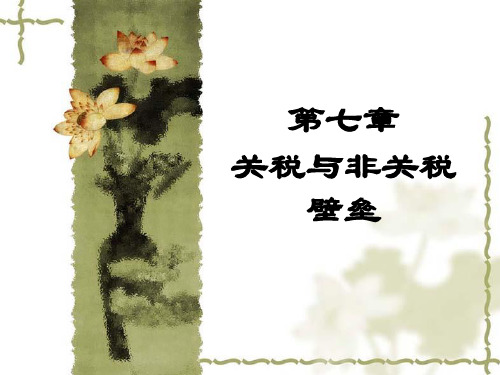
由于支持价格定得不仅高于自由贸易下世界价格而且高 于国内供需相等时的均衡价格。为了出口由此造成的剩余产 品,欧盟不得不通过支付出口补贴来抵消欧洲与世界价格的 差额。得到补贴的出口商品本身又会继续压低世界价格,从 而陷入恶性循环。结果表明,欧洲的消费者和纳税人的综合 损失超过了生产者的所得。 尽管欧洲共同农业政策给欧洲消费者和纳税人带来了净 损失,但欧共体农民的政治压力一直非常强大,以至这一政 策很少遇到自其内部的挑战。对欧洲共同农业政策最大的压 力来自于美国和其他粮食出口国。在乌拉圭回合贸易谈判中, 美国要求其在2000年时完全取消出口补贴。这些要求最终被 大大降低。最后,欧盟同意在六年内减少1/3的补贴。 日本的农业补贴(有时间就介绍)
持续性倾销(persistent dumping)(无限期倾销) 形成持续性倾销的三个条件: (1) 市场是不完全竞争的; (2) 企业在国内外市场所面临需求弹性不同; (3) 国内和国外两个市场是完全隔离的。
倾销不过是 企业利润最 大化的战略
7.4.3反倾销与反倾销税
倾销使进口国同类企业或产业的发展面临着严重 的压力,国内生产者会要求政府采取反倾销 (anti-dumping)政策措施 。 反倾销的一般做法是征收反倾销税。反倾销税是 指,进口国政府在确定外国出口商销售到本国市 场的商品有倾销行为时,对该商品所征收的进口 附加税。 反倾销税的影响。减少国内对低价进口品的需求; 保护国内同类商品的生产者。
国际经济学第九版英文课后答案
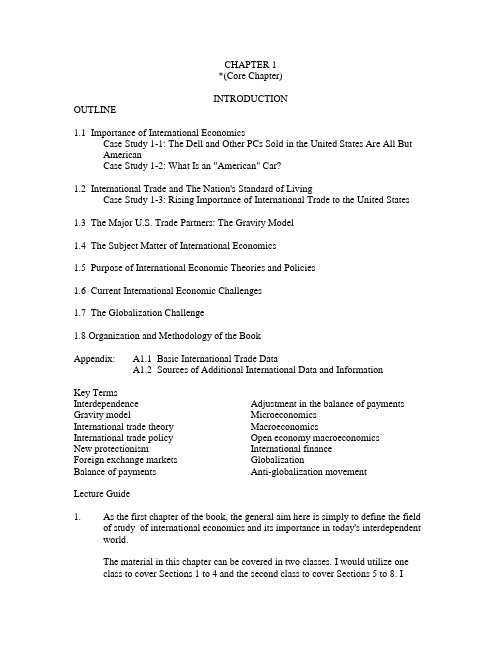
CHAPTER 1
*(Core Chapter)
INTRODUCTION
OUTLINE
1.1 Importance of International Economics
Case Study 1-1: The Dell and Other PCs Sold in the United States Are All But
American
Case Study 1-2: What Is an "American" Car?
1.2 International Trade and The Nation's Standard of Living
Case Study 1-3: Rising Importance of International Trade to the United States 1.3 The Major U.S. Trade Partners: The Gravity Model
1.4 The Subject Matter of International Economics
1.5 Purpose of International Economic Theories and Policies
1.6 Current International Economic Challenges
1.7 The Globalization Challenge
1.8 Organization and Methodology of the Book
Appendix: A1.1 Basic International Trade Data
- 1、下载文档前请自行甄别文档内容的完整性,平台不提供额外的编辑、内容补充、找答案等附加服务。
- 2、"仅部分预览"的文档,不可在线预览部分如存在完整性等问题,可反馈申请退款(可完整预览的文档不适用该条件!)。
- 3、如文档侵犯您的权益,请联系客服反馈,我们会尽快为您处理(人工客服工作时间:9:00-18:30)。
CHAPTER 7
ECONOMIC GROWTH AND INTERNATIONAL TRADE
OUTLINE
7.1 Introduction
7.2 Growth of Factors of Production
7.2a Labor Growth and Capital Accumulation Over Time
7.2b The Rybczynski Theorem
7.3 Technical Progress
7.3a Neutral, Labor-Saving, and Capital-Saving Technical Progress
7.3b Technical Progress and the Nation's Production Frontier
Case Study 7-1: Changes in Relative Resource Endowments of Various Countries and Regions Case Study 7-2: Change in Capital-Labor Rations in Selected Countries
7.4 Growth and Trade: The Small Country Case
7.4a The Effects of Growth on Trade
7.4b Illustration of Factor Growth, Trade, and Welfare
7.4c Technical Progress, Trade, and Welfare
Case Study 7-3: Growth of Output per Worker from Capital Deepening, Technological
Change, and Improvements in Efficiency
7.5 Growth and Trade: The Large-Country Case
7.5a Growth and the Nation's Terms of Trade and Welfare
7.5b Immiserizing Growth
7.5c Illustration of Beneficial Growth and Trade
Case Study 7-4: Growth, Trade, and the Giants of the Future
7.6 Growth, Change in Tastes, and Trade in Both Nations
7.6a Growth and Trade in Both Nations
7.6b Change in Tastes and Trade in Both Nations
Case Study 7-5: Change in the Revealed Comparative Advantage of Various Countries or Regions
Case Study 7-6: Growth, Trade, and Welfare in the Leading Industrial Nations
Appendix: A7.1 Formal Proof of Rybczynski Theorem
A7.2 Growth with Factor Immobility
A7.3 Graphical Analysis of Hicksian Technical Progress
Key Terms
Comparative statics Antitrade production and consumption
Dynamic analysis Neutral production and consumption
Balanced growth Normal goods
Rybczynski theorem Inferior goods
Labor-saving technical progress Terms-of-trade effect
Capital-saving technical progress Wealth effect
Protrade production and consumption Immiserizing growth
Lecture Guide
1.This is not a core chapter and it is one of the most challenging chapters in international trade
theory. It is included for more advanced students and for completeness.
2.If I were to cover this chapter, I would present two sections in each of three lectures.
Time permitting, I would, otherwise cover Sections 1 and 2, paying special attention to the
Rybczynski theorem.
Answer to Problems
1. a) See Figure 1.
b) See Figure 2
c) See Figure 3.
2. See Figure 4.
3. a) See Figure 5.
b) See Figure 6.
c) See Figure 7.
4. Compare Figure 5 to Figure 1.
Compare Figure 6 to Figure 3. Note that the two production frontiers have the same vertical or Y intercept in Figure 6 but a different vertical or Y intercept in Figure 3.
Compare Figure 7 to Figure 2. Note that the two production frontiers have the same
horizontal or X intercept in Figure 7 but a different horizontal or X intercept in Figure 2.
5. See Figure 8 on page 6
6.
6. See Figure 9.
7. See Figure 10.
8. See Figure 11.
9. See Figure 12.
10. See Figure 13 on page 67.
